For our second #Hyperchat we looked into what is probably one of the most critical conversations we’re going to have as a society in the coming months: the vaccine for COVID-19 and the conversation taking place on social media around vaccination.
Our virtual event brought together vaccine and communication experts from all over the world. Science journalist Vaccines Europe editor Gary Finnegan joined us from Ireland. Jane Barratt called in from Canada where she runs the IFA. Influenza specialist Bram Palache resides in the Netherlands and Brian Yau from WHO’s @VaccineSafetyN is based in Geneva. And, the advantage of these online discussions, we were able to have people from all over the world listening in to what is, of course, a global question.
The core of the question is how COVID-19 is going affect the vaccines conversation. Is it going to make the anti-vaxxers more aggressive? Is it going to lead to more vaccine hesitancy, or will people decide they want the vaccine and the discussion will go the other way? And is this crisis an opportunity to be grasped? Here’s what our main speakers concluded:
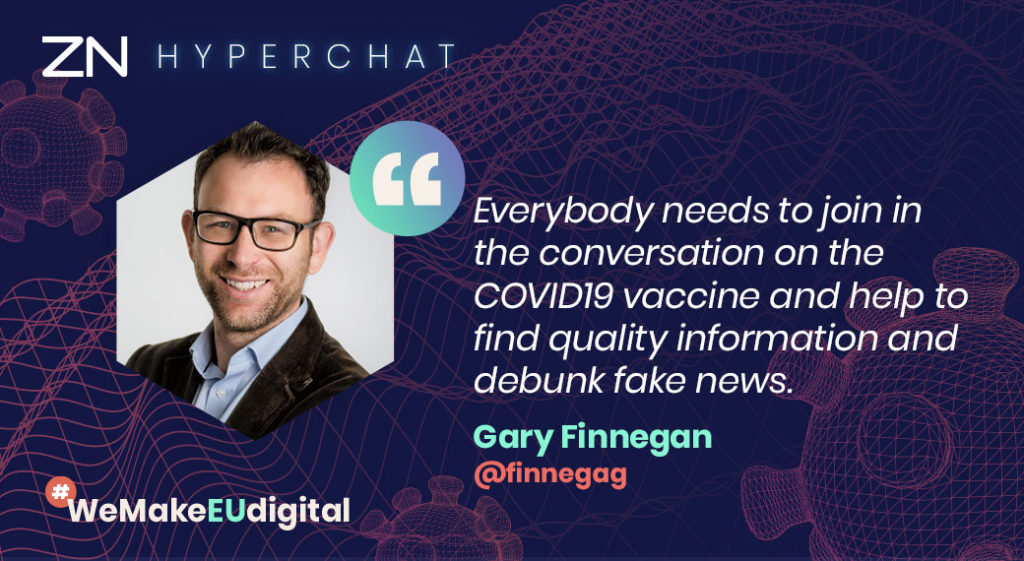
“I think this is an opportunity, but also we should careful that things could slide back to just the way they were. So, we have to work hard to sustain the bits we really want to keep, the networks, the community, focussing on healthcare professionals.”
“We should never forget to rely on valid and reliable information when trying to answer a vaccine related question.” highlights @BPalache as we are closing today’s #Hyperchat pic.twitter.com/Ed3BRK99oW
— ZN (@ZNConsulting) May 20, 2020
“We should never forget the need for valid information. Emotion is fine, but not emotion against emotion, that’s out of the question for me.”
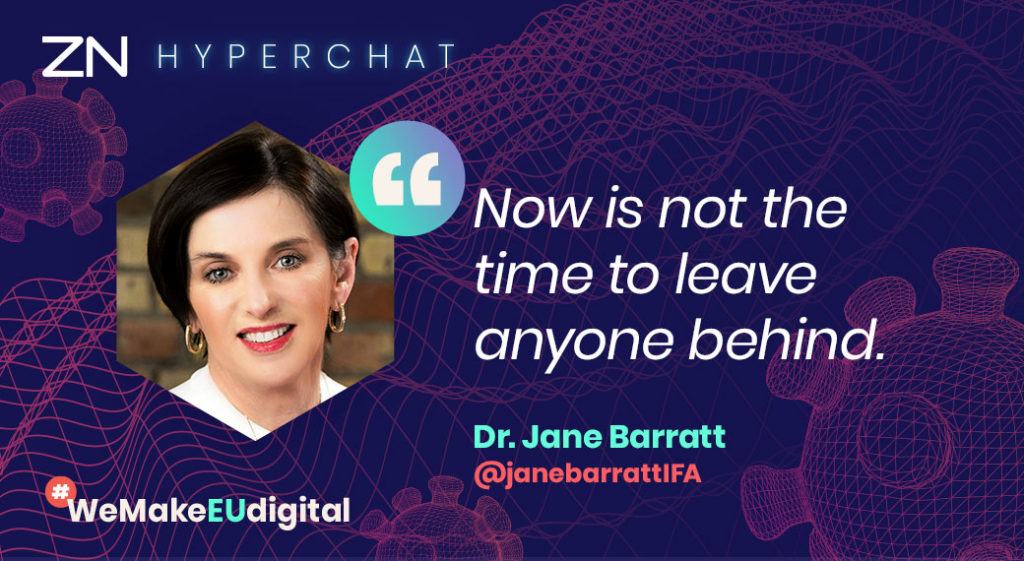
“As the world is closing its borders it is also uniting in the fight against the virus. Now is the time to put public health front and centre and leave no one behind including older people and those with underlying conditions.”
I concluded that vaccine supporters should meet the challenge of understanding the other side, as Gary underlined. I was also struck by Bram’s point about how society underestimates influenza and the disease we are used should not get lost in the overwhelming narrative around COVID-19. Neither should we overlook a population that Jane feels is being neglected: we need to keep bringing older people back to the forefront of the conversation.
But above all, I feel we need to be smarter about this very difficult conversation. There is a lot of emotion on both sides, but we need discussions to be able to focus on the rational and help people dig deeper into the facts.
“We need to be smarter and digging deeper when we are having the difficult conversation around vaccines.” says @pweiss and we couldn’t agree more.
— ZN (@ZNConsulting) May 20, 2020
Share you thoughts #Hyperchat pic.twitter.com/Ha9TJvF4KZ
But back to how the discussion played out. The first speaker I introduced was Gary Finnegan, three-time winner of the EU health prize for journalists, and who has been with @VaccinesToday for a decade. He’s been very much on the front line of the vaccine conversation – and on the receiving end of anti-vax activity – on social media. I asked him how he thought the conversation was evolving?
Gary recalled that reviews of the H1N1 pandemic ten years ago pointed to communication failures. As ZN noted at the time, though conversations had started out neutral they then shifted to the negative as pro-vaccine voices were not sufficiently present. “Now we’re definitely seeing increased activity, new people who suddenly have a strong desire for information or a solution. Some of the milder vaccine sceptics have gone quiet as they shift away from complacency.” This, he explained, is the biggest of the 3 Cs of vaccine hesitancy: complacency, convenience and confidence.
On our #Hyperchat we are discussing social media and #vaccines at the times of corona. @finnegag #WeMakeEuDigital pic.twitter.com/UmfUtpERoA
— ZN (@ZNConsulting) May 20, 2020
“Hardliners have gotten harder,” he continued, “more convinced than ever that vaccines are a scam – there’s been a film, Plandemic, going round that suggests the whole thing was invented either by industry or governments – or even Bill Gates, who’s been on the receiving end of lots of this.” Obviously, he admitted, some concerns about a potential vaccine for COVID-19 are legitimate, such as whether we will be able to trust the result of an accelerated development programme. “But there has been less activity from parents previously concerned about toxic chemicals, as maybe COVID-19 has led them to reassess the dangers of diseases.”
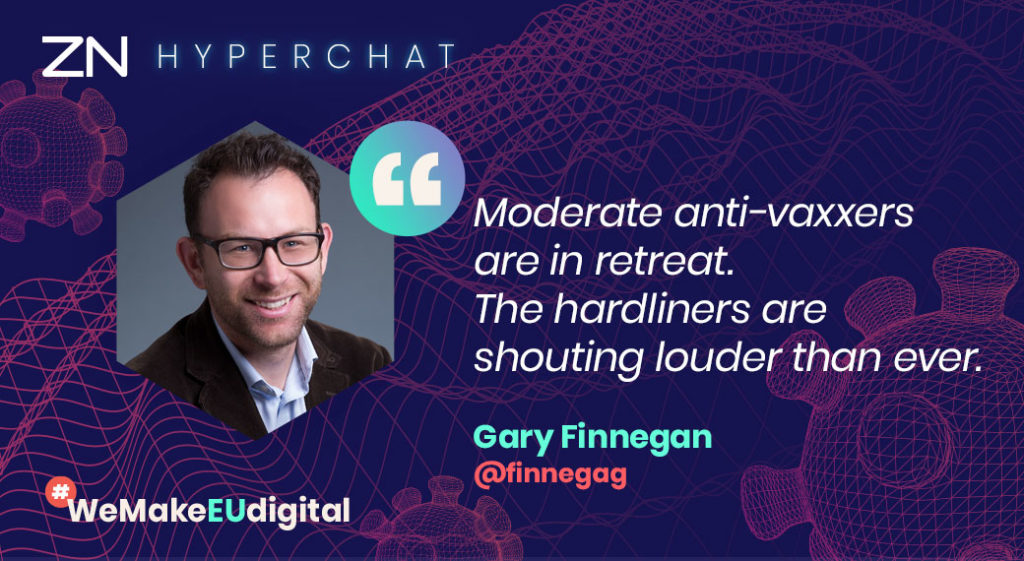
Gary thinks that greater responsibility among tech platforms will probably be a legacy of COVID-19 (as we discussed in our first Hyperchat). “I conducted an experiment, setting up a handle @coronavaccine and retweeting mainstream material from scientific publications – and Twitter shut it down in 24 hours!”
Hypermoderator Liora Kern passed on a remark on Twitter about anti-GMO activists pushing the anti-vax narrative, asking Gary what he thought.
“There’s a strong overlap between anti-science and anti-government groups and cross-fertilisation of suspicions that drive the anti-vax movement,” he responded. “Recently, anti-vaxxers have been merging with 5G conspiracy theorists and, especially in the US, libertarians wanting to end the lockdown and who have other agendas.”
Liora then released the results of the first poll:
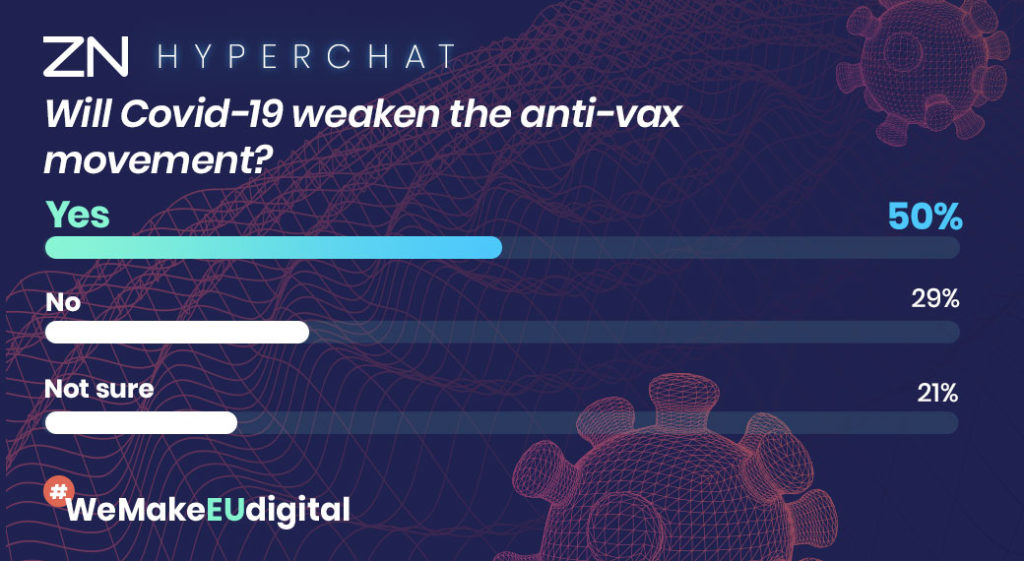
Gary said he hadn’t voted, but would have gone for “not sure”, as it depends on who dominates the online conversation. But there was an upside to hardliner anti-vaxxers becoming more extreme and putting people off their message: “The madder they get, the better!”
To avoid zoom fatigue during our events, we make them as interactive as possible. We ask the audience questions, conduct polls, keep speaker contributions short and sweet and bring the often silent participants in to ask questions on camera.
We also had our social media team (this time Evilenia Tsimpoura, Luiza Fundătureanu, Jeff Antunes, Marisa Veloso Ferreira, Mariana Antunes & Juliette Bonnin) taking the conversation to social media so a wider audience was able follow the conversation in real time with quoted images and live tweeting and instagramming. Daniel Bartual and Nicolas Charloteaux made sure we capture the highlights of the event in a strong video.
Our social media team is ready to activate our virtual #Hyperchat from their homes. We’re so pleased to welcome you! Want to play an active role in this Hyperchat? Start talking with us and those around you by using the hashtag #hyperchat! #WeMakeEuDigital 💪 pic.twitter.com/m8lZOnl5TI
— ZN (@ZNConsulting) May 20, 2020
Next up was Brian Yau, who introduced his WHO project, the Vaccine Safety Net. It has 88 members (including Vaccines Today that ZN has just built a new website for) from 39 countries, making information readily available in 35 languages. With 2 million new users every month, last year 72 million pages were viewed on VSN websites.
Each member has been verified by the WHO against criteria developed by the its Global Advisory Committee on Vaccine Safety and they are continuously monitored for content, scientific accuracy, design and accessibility. “The current pandemic is a global issue, where we want every country to be equally well-informed and each member to be equally well-equipped.” The organisation provides data and analysis and has expanded its Google analytics programme to include measurement of social channels to identify pockets that science-led information is not reaching and help the network tailor their communications on social media where the majority of misinformation is circulating.
“Providing insights, data and analysis for the public is important in order to encourage knowledge sharing and collaboration.” states @VaccineSafetyN.
— ZN (@ZNConsulting) May 20, 2020
We appreciate the work of all those fighting to ensure quality communication during the time of corona. #Hyperchat pic.twitter.com/G09xGj6hu0
“Pinterest has already agreed to only surface vaccine-related results from leading public health organizations and our aim is to work with all channels to make the information available to them from all our members, so that it can come from a wider range of sources,” he told us.
I jumped in to ask Brian whether he had seen a surge in searches and whether disinformation was going to get worse or better around COVID-19?
“We actually saw a flattening of the curve in anti-vax activity at the start of the pandemic, because it’s much harder to argue against the efficacy of a vaccine when you’re in the middle of a pandemic, but, as Gary pointed out, the motives of the anti-vax community are beyond just wanting to share so they will be back and we are preparing for the worst.” VSN’s various projects are currently all aimed at developing communication for when a vaccine becomes available.
By way of introduction to our next speaker, Dr Jane Barratt, Secretary General of the International Federation on Ageing, Hypermoderator Liora polled the audience on the effect of the virus on ageism.
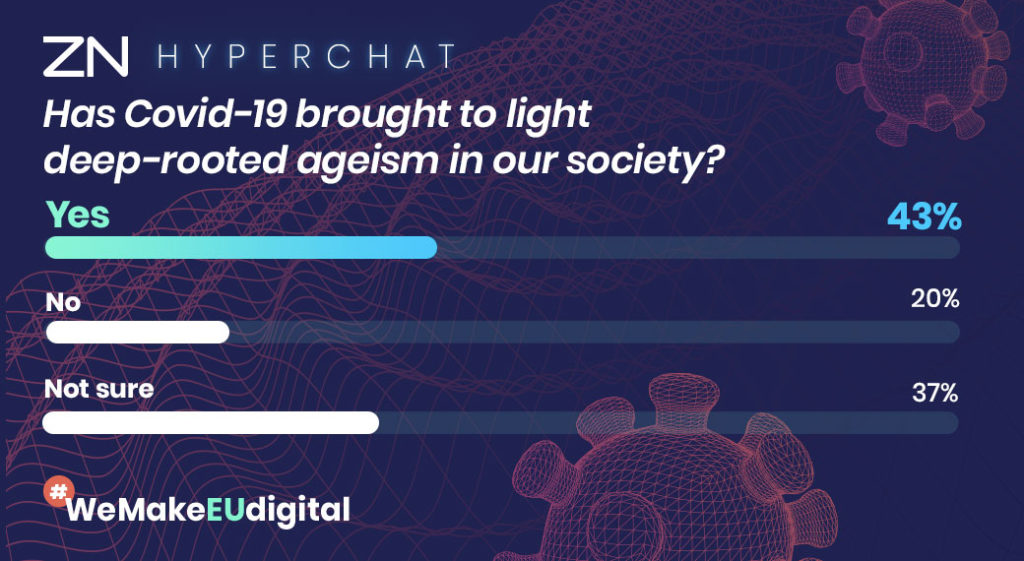
In her role of running the IFA, Jane is very focused on the issue of vaccination and started by explaining how the IFA established a Vaccines 4 Life programme to focus on improving uptake rates among adults. “Vaccination of older people doesn’t seem to be high on the agenda of many governments around the world, but it is one the most effective public health interventions. It saves millions of lives every year.”
But, she wondered, with three wake-up calls in the past – HIV, Ebola and H1N1, “why are we asleep at the wheel? Because prior epidemics did not affect every country in the world or every age group.”
“Ageism is very much part of this conversation,” she said, asking pointedly, “Why is it that in some countries, people who are 70 years of age do not get triaged into treatment for COVID, but a 50-year-old with cardiovascular disease or diabetes does?”
Stepping back from COVID-19 to consider respiratory diseases for which a vaccine exists – influenza, pneumococcal pneumonia, shingles – she deplored “abysmal” uptake rates generally and called into question lower WHO influenza vaccination targets for adults than for children, seeing this as an aspect of ageism. But in the current pandemic, “Where I live in Ontario, seven out of ten deaths are in nursing homes. 50% of people who have died in Europe are older people. Would we think that was acceptable in normal times?”
“While we’re waiting for this effective vaccine and trying to work out where older people fit in that queue for the vaccine, my guess is we’re not going to be front and centre.”
I agreed that working out whether an older life was worth more or less than a younger one is a challenging moral dilemma and pointed out that the older population has been at risk of influenza for a long time, but there has been no equivalent media coverage to that surrounding COVID-19.
Jane remarked on the “intersectionality of ageism and race and socio-economic status” in the COVID situation. Ageism works in both directions, she went on, with the virus being called the “boomer remover”, but younger people being known as “vectors”. “But at the heart of this, we’re dealing with a broken and inadequate healthcare system. When we’re having conversations on social media, we should be talking about the policy implications.”
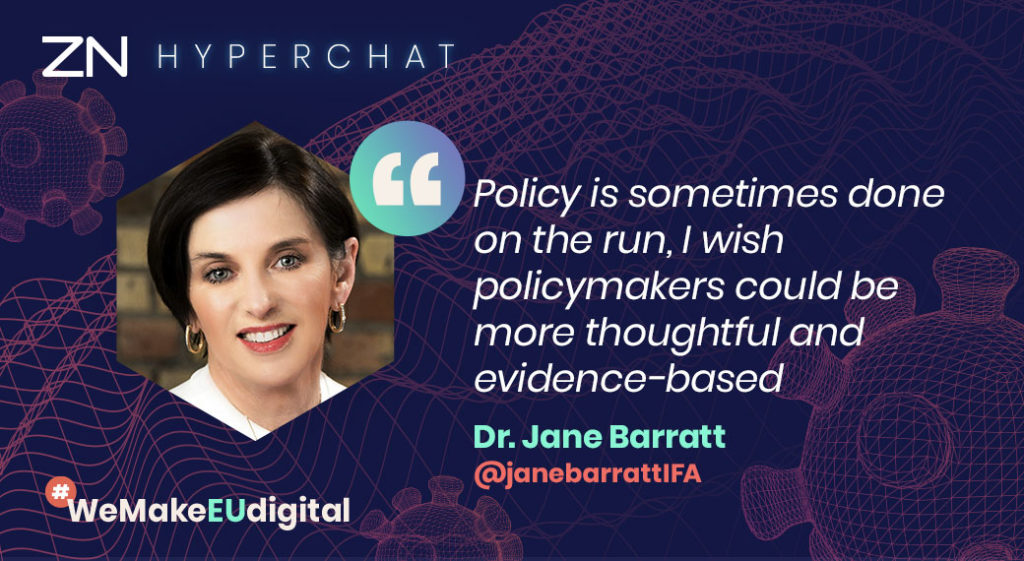
I then introduced Dr Bram Palache as a leading vaccination expert perfectly placed to explain how we can understand a potential vaccine for COVID-19 in relation to existing vaccines for influenza.
The coronavirus and influenza are both airborne infections, Bram explained, unrelated to behaviour so everyone is at risk. Another parallel is that the 2017-18 influenza season in the Netherlands led to 9,000 excess deaths, which is the same as the current toll for COVID-19. The disease burden of influenza occurs every year and the same population is at risk of serious complications and death: older people and those with underlying health conditions.
“With pandemic fatigue, it’s too difficult to get attention for pandemic preparedness. Influenza is giving you the infrastructure, production and opportunity to learn and do better next year. “@BPalache on #vaccines during the time of corona #Hyperchat #WeMakeEuDigital pic.twitter.com/7jOW9YM6Qq
— ZN (@ZNConsulting) May 20, 2020
“However, in contrast to corona, we don’t see this societal interest, we don’t have daily numbers of influenza hospitalizations or deaths reported. They appear after a year in national statistics, but we are not aware of the disease burden of influenza. And we’re hardly using the safe and effective influenza vaccines that have been around for 70 years.””
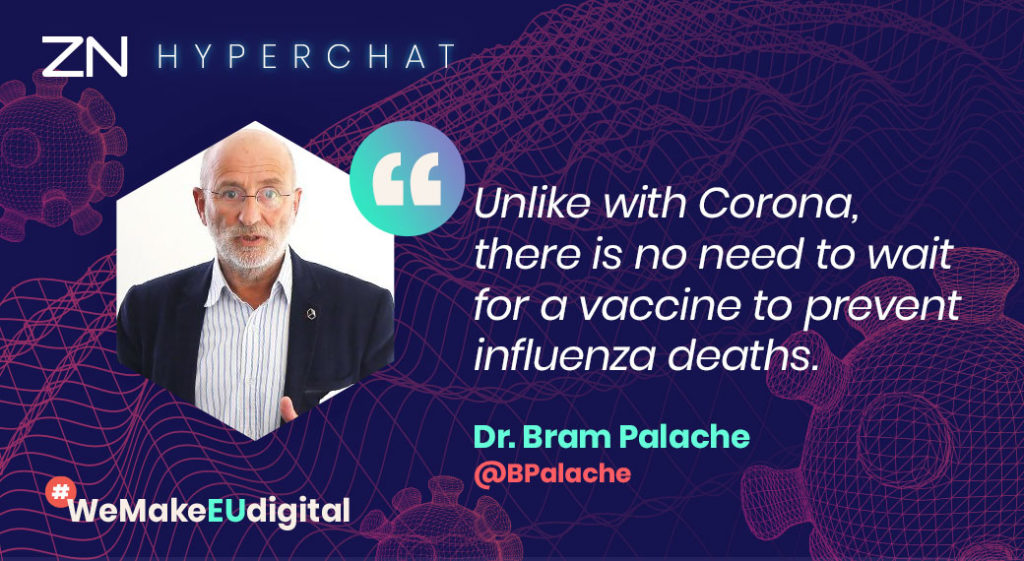
“Perhaps social media can take advantage of the fact people are now much more aware of hospitalizations and critical care, surge capacity, etc. to push for greater uptake of vaccines for diseases we can prevent.”
Jane agreed, calling for action to increase uptake rates for the influenza vaccine: “We will need those beds for the second wave of COVID.”
Bram added that “Annual flu immunization campaigns are also a fantastic way to prepare for another pandemic: at least you’d have your infrastructure ready.”
Next, Hypermoderator Liora brought in The Risk-Monger, David Zaruk, on video. He pointed out that anti-vaxxers also include some medical practitioners concerned about certain adjuvants so “kicking all their posts off social media is not an interesting way to engage the debate.” He fears that communication is by “vaccine vigilantes” who shut down the conversation if people question anything is counterproductive and wondered: “Have we created this monster?”
“Some of the pro-vaccine doctors can be almost as bad at getting abusive as the anti-vaxxers,” admitted Gary, “Reasonable questions need reasonable answers.”
“We need to be honest, have integrity and have the space for conversation,” Jane responded.
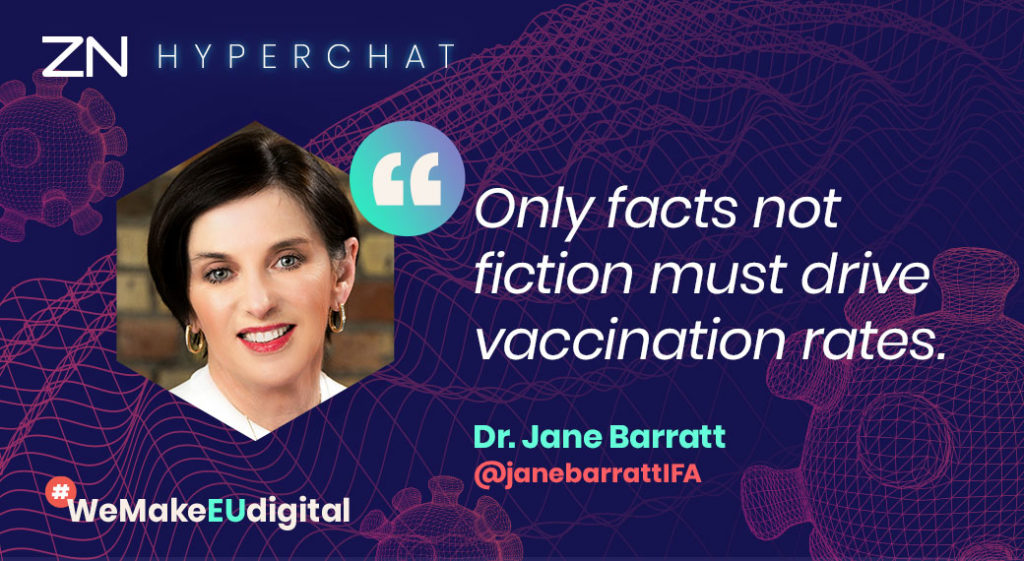
There was still some time, so Liora called on participant Ber Oomen from the European Specialist Nurses Organisation to share his thoughts on video. He pointed out that his kids don’t use Twitter anymore, so we need to think of using a broader social media context to educate about viruses and vaccination.
Gary agreed and said VaccinesToday is thinking of moving to Instagram and TikTok to reach younger people, even if Facebook is still very good for the ‘adult’ audience while Twitter is great for stakeholders, policymakers, media, experts etc. “Unfortunately, we need to do it all!”
I pointed out that the WHO has made successful videos on TikTok and wondered if this wasn’t a perfect time to create online education programmes to explain, for example, how to analyse data.
Jane agreed that education is very important, but expressed a concern that disadvantaged sectors of society and less developed countries would have difficulty accessing online materials.
I countered that these countries often have adequate mobile penetration for WhatsApp etc. to reach people.
Liora then read out a comment on the chat by Marko from the European Pharmaceutical Students Association saying they actively advocate for regular Public Health Campaigns and spreading the word on Instagram.
ZN’s creative director Jesus Azogue joined the conversation to point out that anti-vaxxers tend to move quickly with messages based on emotions whereas the pro-vaccine community uses facts and do not have the same amount of time to react online. However, as the lockdown has brought emotions to the fore it is a good opportunity to put that at the service of vaccines.
Gary responded that the advantage of anti-vaxxers is they have no real accountability. “If it becomes a battle of fear versus fear,” he added, “that can be paralysing for people having to make decisions about whether to vaccinate.”
Finally, Liora presented the results of the third poll:
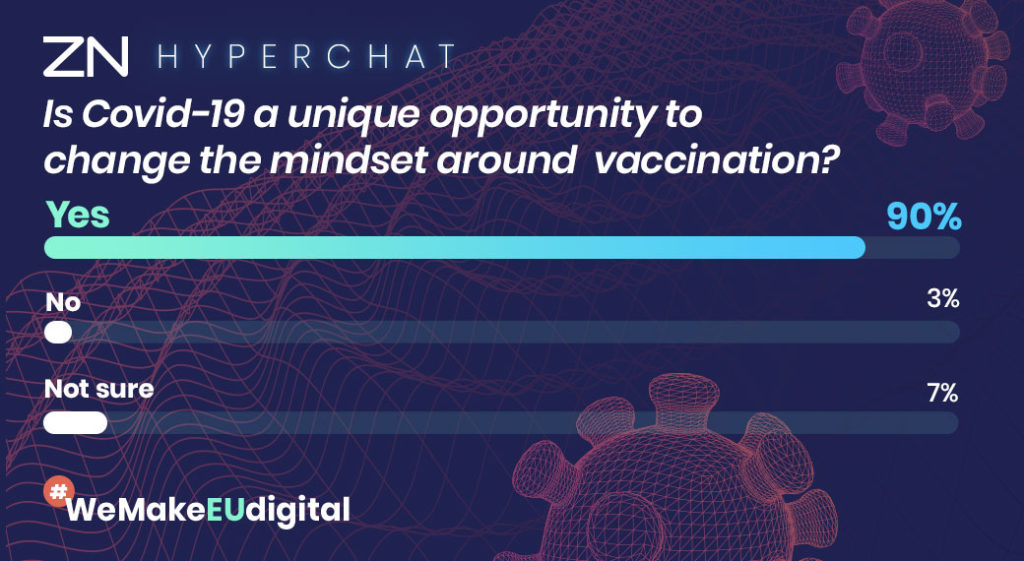
As always, I called for the conversation to continue on Twitter and reminded everyone:
“Think before you post!”
We ended by opening everyone’s mikes for a round of applause 😃
#VirtualEvents #WeMakeEUdigital #Hyperthinking
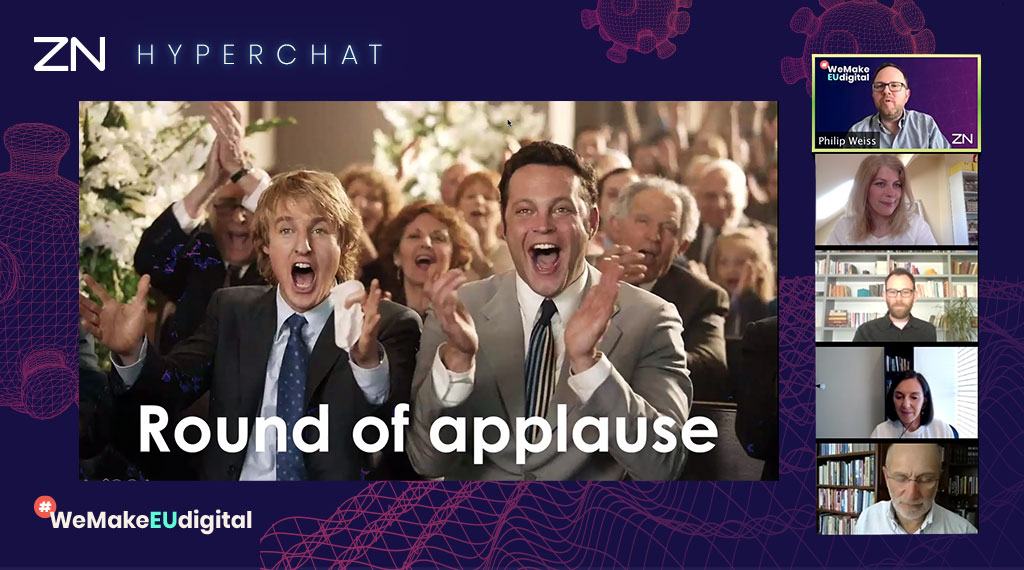
And I was really pleased to see these comments in the chat box.
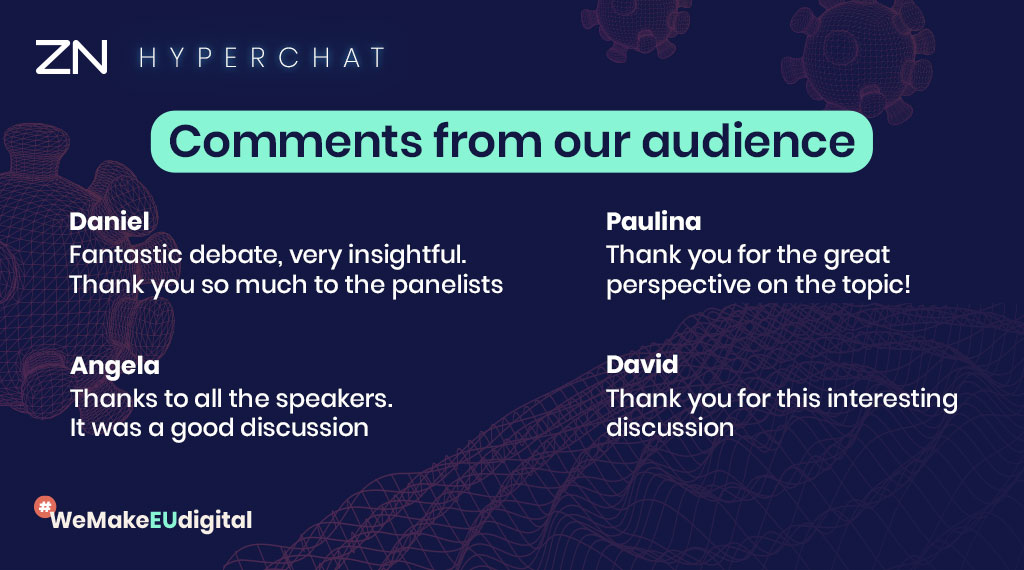
Looking forward to next time!
Philip Weiss, ZN CEO











